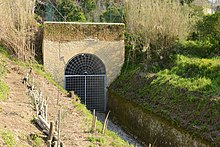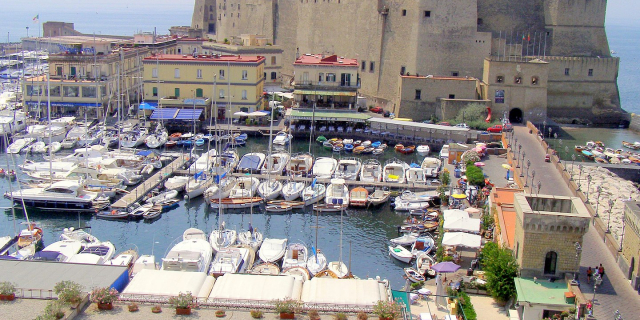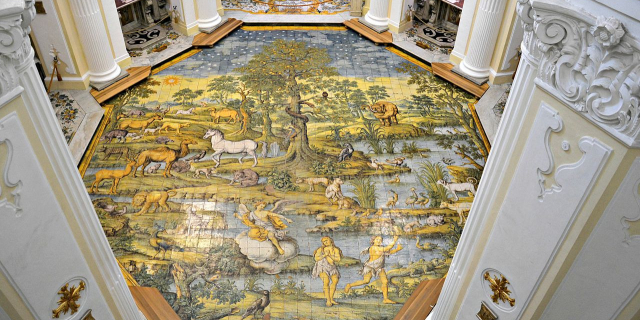Cumae (Ancient Greek: Κύμη, romanized: (Kumē) or Κύμαι (Kumai) or Κύμα (Kuma); Italian: Cuma) was the first ancient Greek colony of Magna Graecia on the mainland of Italy, founded by settlers from Euboea in the 8th century BC and soon became one of the strongest colonies. It later became a rich Roman city, the remains of which lie near the modern village of Cuma, a frazione of the comune Bacoli and Pozzuoli in the Metropolitan City of Naples, Campania, Italy.
The archa...Read more
Cumae (Ancient Greek: Κύμη, romanized: (Kumē) or Κύμαι (Kumai) or Κύμα (Kuma); Italian: Cuma) was the first ancient Greek colony of Magna Graecia on the mainland of Italy, founded by settlers from Euboea in the 8th century BC and soon became one of the strongest colonies. It later became a rich Roman city, the remains of which lie near the modern village of Cuma, a frazione of the comune Bacoli and Pozzuoli in the Metropolitan City of Naples, Campania, Italy.
The archaeological museum of the Campi Flegrei in the Aragonese castle contains many finds from Cumae.
 The lower city of Cumae seen from the acropolis
The lower city of Cumae seen from the acropolisThe oldest archaeological finds by Emil Stevens in 1896 date to 900–850 BCE[1][a] and more recent excavations have revealed a Bronze Age settlement of the ‘pit-culture’ people, and later dwellings of Iron Age Italic peoples whom the Greeks referred to by the names Ausones and Opici (whose land was called Opicia).
The Greek settlement was founded in the 8th century BCE by emigrants from cities of Eretria and Chalcis in Euboea, next to an Opician settlement. The Greeks were already established at nearby Pithecusae (modern Ischia)[3] and were led to Cumae by the joint oecists (founders): Megasthenes of Chalcis and Hippocles of Cyme.[b]
The site chosen was on the hill and later acropolis of Monte di Cuma surrounded on one side by the sea, and on the other by particularly fertile ground on the edge of the Campanian plain. While continuing their maritime and commercial traditions, the settlers of Cumae strengthened their political and economic power by exploitation of the land and extended their territory at the expense of neighbouring peoples.
The colony thrived and in the 8th century BCE it was already strong enough to send Perieres to found Zancle in Sicily,[4] and another group to found Tritaea in Achaea, Pausanias was told.[5] Cuma established its dominance over almost the entire Campanian coast up to Punta Campanella over the 7th and 6th centuries BCE, gaining sway over Puteoli and Misenum.
The colony spread Greek culture in Italy and introduced a dialect of Greek, and the Euboean alphabet, a variant of which was adapted and modified by the Etruscans and then re‑adapted by the Romans and became the Latin alphabet, still used worldwide today.
According to Dionysius of Halicarnassus,
Cumae was at that time celebrated throughout all Italy for its riches, power, and all the other advantages, as it possessed the most fertile part of the Campanian plain and was mistress of the most convenient havens round about Misenum.[6]The growing power of the Cumaean Greeks led many indigenous tribes of the region to organise against them, notably the Dauni and Aurunci with the leadership of the Capuan Etruscans. This coalition was defeated by the Cumaeans in 524 BCE[7] at the first Battle of Cumae under the direction of Aristodemus. The glorious victories of the colony increased its prestige, so much so that according to Diodorus Siculus, it was usual to associate the whole region of the Phlegraean Fields with Cumaean territory.
At this time the Roman senate sent agents to Cumae to purchase grain in anticipation of a siege of Rome.[8] Then in 505 BCE Aristodemus led a Cumaean contingent to assist the Latin city of Aricia in defeating the Etruscan forces of Clusium (see also War between Clusium and Aricia) and having attained the people's favour he overthrew the aristocratic faction and became a tyrant himself. It was probably at this point that Cumae founded Neapolis (“new city”) in the late 6th century BCE.
Further contact between the Romans and the Cumaeans occurred during the reign of Aristodemus. Tarquinius, the last of the legendary Kings of Rome, lived his life in exile with Aristodemus at Cumae after the Battle of Lake Regillus and died there in 495 BCE.[9][10] Livy records that Aristodemus became the heir of Tarquinius, and in 492 BCE when Roman envoys travelled to Cumae to purchase grain, Aristodemus seized the envoys' vessels on account of the property of Tarquinius which had been seized at the time of Tarquinius' exile.[11]
Eventually, the dispossessed nobles and their sons were able to take over Cumae in 490 BCE, and executed Aristodemus.[12][13]
The combined fleets of Cumae and Syracuse (on Sicily) defeated the Etruscans at the Battle of Cumae in 474 BCE.
The temple of Apollo sent the revered Sibylline Books to Rome in the 5th c. BCE. Also Rome obtained its priestesses who administered the important cult of Ceres from the temple of Demeter in Cumae.
Oscan and Roman Cumae Entrance to the Cave of the Sibyl
Entrance to the Cave of the Sibyl The Temple of Zeus at Cumae was converted into a paleochristian basilica. The baptismal font can still be seen in the back of the building.
The Temple of Zeus at Cumae was converted into a paleochristian basilica. The baptismal font can still be seen in the back of the building. Grotta di Cocceio
Grotta di CocceioThe Greek period at Cumae came to an end in 421 BC, when the Oscans allied to the Samnites broke down the walls and took the city, ravaging the countryside.[14][15] Some survivors fled to Neapolis.
The walls on the acropolis were rebuilt from 343 BC. Cumae came under Roman rule with Capua and in 338 BC was granted partial citizenship, a civitas sine suffragio. In the Second Punic War, in spite of temptations to revolt from Roman authority,[16] Cumae withstood Hannibal's siege, under the leadership of Tib. Sempronius Gracchus.[17]
The city prospered in the Roman period from the 1st c. BC along with all the cities of Campania and especially the bay of Naples as it became a desirable area for wealthy Romans who built large villas along the coast. The "central baths" and the amphitheatre are built.
During the civil wars Cumae was one of the strongholds that Octavian used to defend against Sextus Pompey. Under Augustus extensive public building works and roads were begun and in or near Cumae several road tunnels were dug: one through the Monte di Cumae linking the forum with the port, the Grotta di Cocceio 1 km long to Lake Avernus and a third, the "Crypta Romana", 180m long between Lake Lucrino and Lake Averno. The temples of Apollo and Demeter were restored.
The proximity to Puteoli, the commercial port of Rome and to Misenum, the naval fleet base, also helped the region to prosper.
Another very important innovation was the construction of the great Serino aqueduct, the Aqua Augusta supplying many of the cities in the area from about 20 BC. Domitian's via Domitiana provided an important highway to the via Appia and thence to Rome from 95 AD.
The early presence of Christianity in Cumae is shown by the 2nd-century AD work The Shepherd of Hermas, in which the author tells of a vision of a woman, identified with the church, who entrusts him with a text to read to the presbyters of the community in Cuma. At the end of the 4th century, the temple of Zeus at Cumae was transformed into a Christian basilica.
The first historically documented bishop of Cumae was Adeodatus, a member of a synod convoked by Pope Hilarius in Rome in 465. Another was Misenus, who was one of the two legates that Pope Felix III sent to Constantinople and who were imprisoned and forced to receive Communion with Patriarch Acacius of Constantinople in a celebration of the Divine Liturgy in which Peter Mongus and other Miaphysites were named in the diptychs, an event that led to the Acacian Schism. Misenus was excommunicated on his return but was later rehabilitated and took part as bishop of Cumae in two synods of Pope Symmachus. Pope Gregory the Great entrusted the administration of the diocese of Cumae to the bishop of Misenum. Later, both Misenum and Cumae ceased to be residential sees and the territory of Cumae became part of the diocese of Aversa after the destruction of Cumae in 1207.[18][19][20] Accordingly, Cumae is today listed by the Catholic Church as a titular see.[21]
Under Roman rule, so-called "quiet Cumae"[22] was peaceful until the disasters of the Gothic Wars (535–554), when it was repeatedly attacked, as the only fortified city in Campania aside from Neapolis: Belisarius took it in 536, Totila held it, and when Narses gained possession of Cumae, he found he had won the whole treasury of the Goths.
Diocese of Cuma(e)A bishopric was established around 450 AD. In 700 it gained territory from the suppressed Diocese of Miseno.
In 1207 it was suppressed when forces from Naples, acting for the boy-King of Sicily, destroyed the city and its walls, as the stronghold of a nest of bandits. Its territory was divided and merged into the Roman Catholic Diocese of Aversa and Roman Catholic Diocese of Pozzuoli. Some of the citizens from Cumae, including the clergy and the cathedral capitular, took shelter in Giugliano.
Resident bishops Saint Massenzio (300? – ?) Rainaldo (1073? – 1078?) Giovanni (1134? – 1141?) Gregorio (1187? – ?) Leone (1207? – ?)Titular seeIn 1970, the diocese was nominally restored as a Latin titular see. The title has been held by:
Bishop Louis-Marie-Joseph de Courrèges d’Ustou (1970.09.02 – 1970.12.10) Archbishop Edoardo Pecoraio (1971.12.28 – 1986.08.09) Bishop Julio María Elías Montoya, O.F.M.
Cite error: There are <ref group=lower-alpha> tags or {{efn}} templates on this page, but the references will not show without a {{reflist|group=lower-alpha}} template or {{notelist}} template (see the help page).

































Add new comment